Calyx in plants merely refers to a sterile outermost whorl or non-reproductive structure, which constitutes perianth. A group of sepals unitedly forms a calyx. Thus, sepals are nothing but the modified leaves, which account for forming the flower’s outermost whorl.
It can be regular or irregular in size and shape, and the number may also vary based on the different plant species. The sepals are sessile, leafy and usually green in colour. But, few flowers may consist of coloured sepals.
The fundamental role of sepals is to ensure proper maturation of flower and protection against drying out condition. In this post, we will study the meaning, features and types of the calyx.
Content: Calyx in Plants
Meaning of Calyx
The calyx is the sterile outermost whorl, which originates directly upwards the stem and encloses the petals and other floral parts inside. It is distinctively referred to as “Sepal”. During bud formation, the sepal remains intact, protecting the bud till it attains maturity. Once a bud blooms into a flower, the whorl of calyx extends from the flower base.
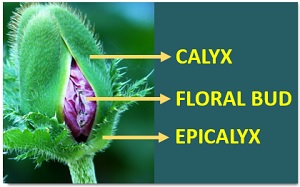
Features
The calyx shows the following characteristics:
- It is the lowermost axillary whorl.
- “Epicalyx” is another structure, which develops from the base of calyx as a whorl of bracteoles in few flowers.
- The sepals are usually green and leaf-like.
- It appears thick and hardy than the leaves and shows veins.
- It consists of stomata like in ordinary leaves.
- The calyx can be free or fused in origin.
- In the fused calyx, sepals form a calyx tube when the fusion occurs towards the base, and the remaining free portion refers to calyx limbs.
- When the sepals appear like petals, they are called “Tepals”.
- Sometimes, a group of sepals undergo modifications to develop several appendages, depending upon the environmental adaptation.
- In the majority of plants, sepal drops off as the flower blooms. But, in few plants, sepals remain intact till the petals fall off, and few remain intact permanently with the fruit.
Types of Calyx
The calyx may differ in size, structure, loss or persistence in different plants, depending upon which the calyx is classified into the following types.
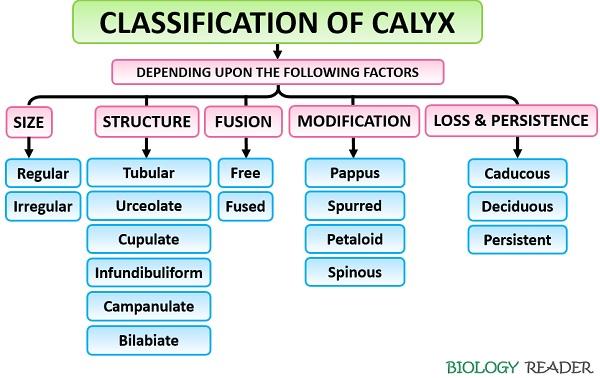
Depending upon the size of the calyx
- Regular: The sepals of the calyx exhibits the same size, as in China rose.
- Irregular: Here, the sepals exhibit different sizes, as in Cliteria sp.
Depending upon the structure of calyx
- Tubular: The sepals appear tube-like, as in Nicotiana species.
- Infundibuliform: Calyx resembles a funnel shape, like in Atropa belladonna.
- Urceolate: The sepals appear as urn-shaped, like in Hyoscyamus species.
- Bilabiate: It consists of two lips, as in Ocimum and Salvia species.
- Campanulate: Calyx seems like a bell shape, as in Lathyrus odoratus.
- Cupulate: The calyx seems cup-like, as in Gossypium species.
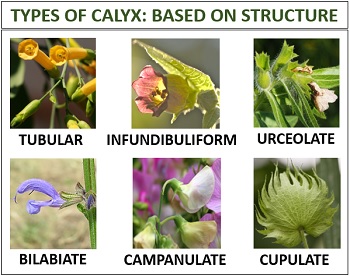
Depending upon the fusion of sepals
- Gamosepalous: In this type, the sepals are fused. Examples: Datura, Hibiscus etc.
- Polysepalous: Here, the sepals are free. Examples: Anona, Tomato etc.
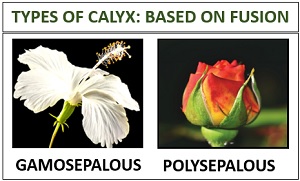
Depending upon the loss and persistence of a calyx
- Caducous: In this type, sepals fall as the flower blooms, like in the poppy plant.
- Deciduous: In this type, sepals fall along with the petals after fertilization, like in the mustard plant.
- Persistent: In this kind, the sepals remain intact with the fruits, like brinjal, chillies etc. It is further categorized into two groups:
- Marcescent: When the persistent calyx acquires a shrivelled appearance and shows no growth after fertilization, known as marcescent calyx. Example; Guava.
- Accrescent: In this type, a persistent calyx simultaneously grows in size with the increasing fruit size even after fertilization and termed as the accrescent calyx. Example; Physalis.
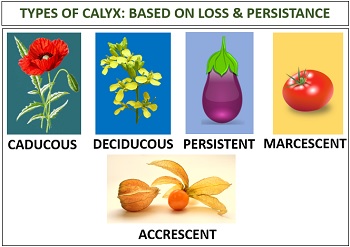
Depending upon the colour of sepals
- Sepaloid: In this type, the sepals are green in colour.
- Petaloid: In this type, the sepals are non-green or colourful like petals. Example: Mirabilis etc.
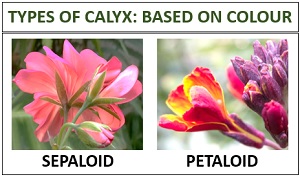
Depending upon the calyx-modification
The structure of calyx modifies into various appendages, and it is categorized into the following types:
- Pappus: Here, the sepals transform into feather-like or hairy structures. Example; Sunflower, Sonchus etc.
- Spurred: The sepals transform into beak-like structures. Example; Delphinium etc.
- Petaloid: Sometimes, the sepals become enlarged and appear brightly coloured like petals. Example; Mussaendra etc.
- Hooded: Here, one of the sepals extends and transforms into hood-like structures over the flower. Example; Aconitum etc.
- Spinous: In this kind, the sepals modify into spines. Example; Trapa etc.
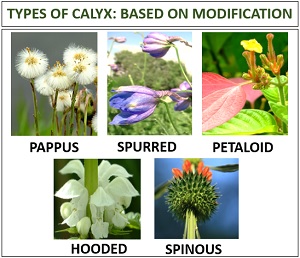
Conclusion
Therefore, the calyx is a group of sepals that functions as an outermost whorl, which harbours the flower from its budding phase to the blooming or flowering stage against harsh environmental conditions desiccation, and sometimes modify to perform special tasks.
Perfect summary